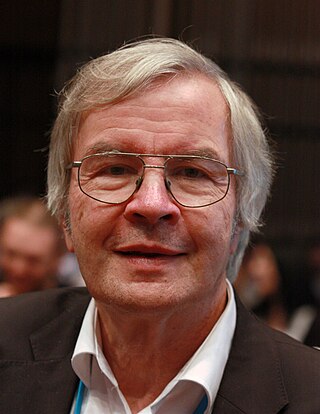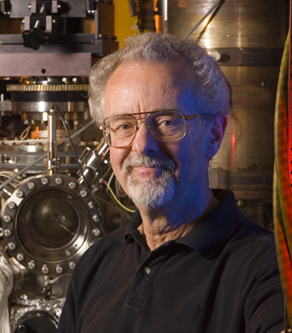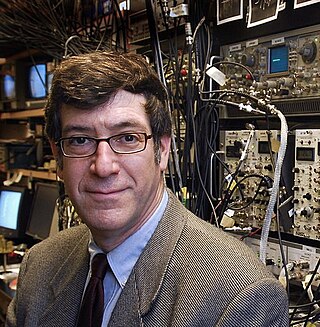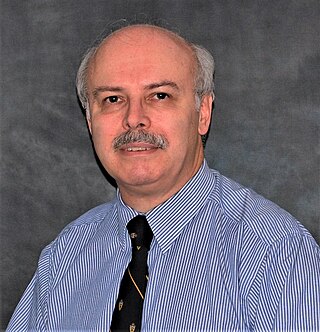
Theodor Wolfgang Hänsch is a German physicist. He received one-third of the 2005 Nobel Prize in Physics for "contributions to the development of laser-based precision spectroscopy, including the optical frequency comb technique", sharing the prize with John L. Hall and Roy J. Glauber.

Earl Ward Plummer was an American physicist. His main contributions were in surface physics of metals. Plummer was a professor of physics at Louisiana State University, University of Pennsylvania and the University of Tennessee - Knoxville.
Margaret Mary Murnane NAS AAA&S is an Irish physicist, who served as a distinguished professor of Physics at the University of Colorado at Boulder, having moved there in 1999, with past positions at the University of Michigan and Washington State University. She is currently Director of the STROBE NSF Science and Technology Center and is among the foremost active researchers in laser science and technology. Her interests and research contributions span topics including atomic, molecular, and optical physics, nanoscience, laser technology, materials and chemical dynamics, plasma physics, and imaging science. Her work has earned her multiple awards including the MacArthur Fellowship award in 2000, the Frederic Ives Medal/Quinn Prize in 2017, the highest award of The Optical Society, and the 2021 Benjamin Franklin Medal in Physics.

Mark George Raizen is an American physicist who conducts experiments on quantum optics and atom optics.

Francisco Javier "Frank" Duarte is a laser physicist and author/editor of several books on tunable lasers.

Johann Rafelski is a German-American theoretical physicist. He is a professor of physics at the University of Arizona in Tucson, guest scientist at CERN (Geneva), and has been LMU-Excellent Guest Professor at the Ludwig Maximilian University of Munich in Germany.

Peter Heszler was a Hungarian physicist. He is well known for, among others, his research on laser-assisted nanoparticle synthesis. His research included nanotechnology, condensed matter physics, materials science, fluctuations and noise, laser science and chemical sensors, including fluctuation-enhanced sensing.
Fritz Peter Schäfer was a German physicist, born in Hersfeld, Hesse-Nassau. He is the co-inventor of the organic dye laser. His book, Dye Lasers, is considered a classic in the field of tunable lasers. In this book the chapter written by Schäfer gives an ample and insightful exposition on organic laser dye molecules in addition to a description on the physics of telescopic, and multiple-prism, tunable narrow-linewidth laser oscillators.
Allan Blaer is a physicist, professor emeritus and special lecturer at Columbia University in New York City. He received his undergraduate degree from Columbia University in 1964, where he was the valedictorian. He later went on to obtain his PhD in physics at the same institution. He has done research in both theoretical and experimental physics. In quantum field theory, he worked on phase transitions in low-temperature bosonic and fermionic systems, quantum field theory anomalies, dyons and magnetic monopoles in non-abelian gauge theories, and renormalization theory. In experimental physics, he has worked on precision measurement of vacuum polarization in muonic atoms to test quantum electrodynamics.
Wilson Marcy Powell was an American physicist and a member of the physics department at the University of California, Berkeley.
Stephan W. Koch was a German theoretical physicist. He was a professor at the University of Marburg and works on condensed-matter theory, many-body effects, and laser theory. He is best known for his seminal contributions to the optical and electronic properties of semiconductors, semiconductor quantum optics, and semiconductor laser designs. Major portion of his research work has focused on the quantum physics and application potential of semiconductor nanostructures. Besides gaining fundamental insights to the many-body quantum theory, his work has provided new possibilities to develop, e.g., laser technology, based on accurate computer simulations. His objective has been to self-consistently include all relevant many-body effects in order to eliminate phenomenological approximations that compromise predictability of effects and quantum-device designs.
Quantum-optical spectroscopy is a quantum-optical generalization of laser spectroscopy where matter is excited and probed with a sequence of laser pulses.

Philip H. Bucksbaum is an American atomic physicist, the Marguerite Blake Wilbur Professor in Natural Science in the Departments of Physics, Applied Physics, and Photon Science at Stanford University and the SLAC National Accelerator Laboratory. He also directs the Stanford PULSE Institute.

Andreas Mandelis is a professor and researcher at the department of Mechanical and Industrial Engineering at the University of Toronto and director of the Center for Advanced Diffusion-Wave and Photoacoustic Technologies (CADIPT). He is an internationally recognized expert in thermophotonics. His research encompasses the non-destructive evaluation of materials with industrial and biomedical applications. He is considered a pioneer in the fields of diffusion-wave, photothermal and photoacoustic sciences and related technologies. He is the inventor of a photothermal imaging radar which can detect tooth decay at an early stage.
Richard Magee Osgood Jr. was an American applied and pure physicist. He was Higgins Professor of Electrical Engineering and Applied Physics at Columbia University.

Carlos Ray Stroud, Jr. is an American physicist and educator. Working in the field of quantum optics, Stroud has carried out theoretical and experimental studies in most areas of the field from its beginnings in the late 1960s, studying the fundamentals of the quantum mechanics of atoms and light and their interaction. He has authored over 140 peer-reviewed papers and edited seven books. He is a fellow of the American Physical Society and the Optical Society of America, as well as a Distinguished Traveling Lecturer of the Division of Laser Science of the American Physical Society. In this latter position he travels to smaller colleges giving colloquia and public lectures.
Szymon Suckewer is a Polish-born American physicist, and professor emeritus at Princeton University. His primary fields of interest include X-ray lasers, and X-ray microscopy, particularly the generation of ultrashort laser pulses which are applied in plasma diagnostics.
David Attwood is an American physicist and professor emeritus at the University of California, Berkeley, where he worked in the field of synchrotron radiation and free-electron lasers, developing X-ray microscopy techniques for research and for the industry. He is the author of a reference book on soft X-rays and extreme ultraviolet radiation.

Randy Alan Bartels is an American investigator at the Morgridge Institute for Research and a professor of Biomedical Engineering at the University of Wisconsin–Madison. He has been awarded the Adolph Lomb Medal from the Optical Society of America, a National Science Foundation CAREER award, a Sloan Research Fellowship in physics, an Office of Naval Research Young Investigator Award, a Beckman Young Investigator Award, and a Presidential Early Career Award for Science and Engineering (PECASE). In 2020 and 2022, he received support from the Chan Zuckerberg Initiative to develop microscope technologies for imaging tissues and cells.









